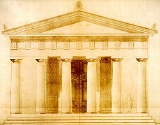
Doric order
Encyclopedia
The Doric order was one of the three orders or organizational systems
of ancient Greek
or classical architecture
; the other two canonical
orders were the Ionic
and the Corinthian
.
s stood directly on the flat pavement (the stylobate) of a temple
without a base; their vertical shafts were fluted with 20 parallel concave grooves
; and they were topped by a smooth capital
that flared from the column to meet a square abacus
at the intersection with the horizontal beam
(entablature
) that they carried. The Parthenon
has the Doric design columns.
 Pronounced features of both Greek and Roman versions of the Doric order are the alternating triglyph
Pronounced features of both Greek and Roman versions of the Doric order are the alternating triglyph
s and metopes
. The triglyphs are decoratively grooved with three vertical grooves ("tri-glyph") and represent the original wooden end-beams, which rest on the plain architrave
that occupies the lower half of the entablature. Under each triglyph are peglike "stagons" or "guttae" (literally: drops) that appear as if they were hammered in from below to stabilize the post-and-beam (trabeated) construction. They also served to "organize" rainwater runoff from above. A triglyph is centered above every column, with another (or sometimes two) between columns, though the Greeks felt that the corner triglyph should form the corner of the entablature, creating an inharmonious mismatch with the supporting column. The spaces between the triglyphs are the "metopes". They may be left plain, or they may be carved in low relief.
The architecture followed rules of harmony. Since the original design came from wooden temples and the triglyphs were real heads of wooden beams, every column had to bear a beam which lay across the centre of the column. Triglyphs were arranged regularly; the last triglyph was centred upon the last column (illustration, right: I.). This was regarded as the ideal solution which had to be reached.
Changing to stone cubes instead of wooden beams required full support of the architrave
load at the last column. At the first temples the final triglyph was moved (illustration, right: II.), still terminating the sequence, but leaving a gap disturbing the regular order. Even worse, the last triglyph was not centered with the corresponding column. That “archaic” manner was not regarded as a harmonious design. The resulting problem is called The doric corner conflict. Another approach was to apply a broader corner triglyph (III.) but was not really satisfying.
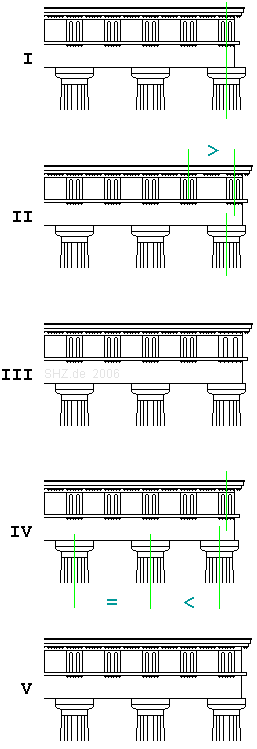
 Because the metopes are somewhat flexible in their proportions, the modular space between columns (“intercolumniation”) can be adjusted by the architect. Often the last two columns were set slightly closer together (corner contraction), to give a subtle visual strengthening to the corners. That is called the “classic” solution of the corner conflict (IV.). Triglyphs could be arranged in a harmonic manner again, and the corner was terminated with a triglyph. However, final triglyph and column were often not centered.
Because the metopes are somewhat flexible in their proportions, the modular space between columns (“intercolumniation”) can be adjusted by the architect. Often the last two columns were set slightly closer together (corner contraction), to give a subtle visual strengthening to the corners. That is called the “classic” solution of the corner conflict (IV.). Triglyphs could be arranged in a harmonic manner again, and the corner was terminated with a triglyph. However, final triglyph and column were often not centered.
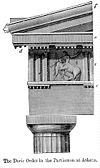 Early examples of the Doric order include the temples at Paestum
Early examples of the Doric order include the temples at Paestum
in southern Italy
, a region called Magna Graecia
, which was settled by Greek colonists and retained a strongly Hellenic culture.
The Temple of the Delians is a “peripteral” Doric order temple, the largest of three dedicated to Apollo
on the island of Delos
. It was begun in 478 BC and never completely finished. During their period of independence from Athens, the Delians reassigned the temple to the island of Poros. It is “hexastyle”, with six columns across the pedimented end and thirteen along each long face. All the columns are centered under a triglyph in the frieze, except for the corner columns. The plain, unfluted shafts on the columns stand directly on the platform (the stylobate), without bases. The recessed “necking” at the top of the shafts and the wide cushionlike echinus are slightly self-conscious archaicizing features, for Delos is Apollo's ancient birthplace.
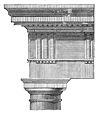 A classic statement of the Greek Doric order is the Temple of Hephaestus
A classic statement of the Greek Doric order is the Temple of Hephaestus
in Athens, built about 447 BC. The contemporary Parthenon
, the largest temple in classical Athens
, is also in the Doric order, although the sculptural enrichment is more familiar in the Ionic order: the Greeks were never as doctrinaire in the use of the Classical vocabulary as Renaissance
theorists or neoclassical
architects. The detail (illustration, left), part of the basic vocabulary of trained architects from the later 18th century onwards, shows how the width of the metopes was flexible: here they bear the famous bas-relief sculptures of the battle of Lapiths and Centaur
s.
In the Roman Doric version (illustration, left), the height of the entablature has been reduced. The endmost triglyph is centered over the column rather than occupying the corner of the architrave. The columns are slightly less robust in their proportions. Below their caps, an astragal molding encircles the column like a ring. Crown molding
s soften transitions between frieze and cornice
and emphasize the upper edge of the abacus
, which is the upper part of the capital. Roman Doric columns also have moldings at their bases and stand on low square pads or are even raised on plinth
s. In the Roman Doric mode, columns are not invariably fluted. Since the Romans dropped the request of the triglyph covered corner, now both columns and triglyphs could be arranged in equidistant order again and well centered together. The architrave corner needed to be left “blank” (illustration, right, V.).
The Roman architect Vitruvius
, following contemporary practice, outlined in his treatise the procedure for laying out constructions based on a module, which he took to be one half a column's diameter, taken at the base. An illustration of Andrea Palladio
's Doric order, as it was laid out, with modules identified, by Isaac Ware, in The Four Books of Palladio's Architecture (London, 1738) is illustrated at Vitruvian module
.
When Greek Revival architecture was introduced at the beginning of the 19th century, the Greek Doric order had not previously been widely used. The first engraved illustrations of the Greek Doric order dated to the mid-18th century. Its appearance in the new phase of Classicism
brought with it new connotations of high-minded primitive simplicity, seriousness of purpose, noble sobriety, and, in the United States, republican
virtues. In a customs house, Greek Doric suggested incorruptibility; in a Protestant church a Greek Doric porch promised a return to an untainted early church; it was equally appropriate for a library, a bank or a trustworthy public utility (illustration, left).
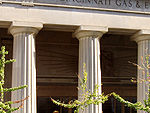 According to Vitruvius the height of Doric columns is six or seven times the diameter at the base. This gives the Doric columns a shorter, thicker look than Ionic columns, which have 8:1 proportions. It is suggested that these proportions give the Doric columns a masculine appearance, whereas the more slender Ionic columns appear represent a more feminine look. This sense of masculinity and femininity was often used to determine which type of column would be used for a particular structure.
According to Vitruvius the height of Doric columns is six or seven times the diameter at the base. This gives the Doric columns a shorter, thicker look than Ionic columns, which have 8:1 proportions. It is suggested that these proportions give the Doric columns a masculine appearance, whereas the more slender Ionic columns appear represent a more feminine look. This sense of masculinity and femininity was often used to determine which type of column would be used for a particular structure.
Classical order
A classical order is one of the ancient styles of classical architecture, each distinguished by its proportions and characteristic profiles and details, and most readily recognizable by the type of column employed. Three ancient orders of architecture—the Doric, Ionic, and Corinthian—originated in...
of ancient Greek
Architecture of Ancient Greece
The architecture of Ancient Greece is the architecture produced by the Greek-speaking people whose culture flourished on the Greek mainland and Peloponnesus, the Aegean Islands, and in colonies in Asia Minor and Italy for a period from about 900 BC until the 1st century AD, with the earliest...
or classical architecture
Classical architecture
Classical architecture is a mode of architecture employing vocabulary derived in part from the Greek and Roman architecture of classical antiquity, enriched by classicizing architectural practice in Europe since the Renaissance...
; the other two canonical
Canonical
Canonical is an adjective derived from canon. Canon comes from the greek word κανών kanon, "rule" or "measuring stick" , and is used in various meanings....
orders were the Ionic
Ionic order
The Ionic order forms one of the three orders or organizational systems of classical architecture, the other two canonic orders being the Doric and the Corinthian...
and the Corinthian
Corinthian order
The Corinthian order is one of the three principal classical orders of ancient Greek and Roman architecture. The other two are the Doric and Ionic. When classical architecture was revived during the Renaissance, two more orders were added to the canon, the Tuscan order and the Composite order...
.
History
In their original Greek version, Doric columnColumn
A column or pillar in architecture and structural engineering is a vertical structural element that transmits, through compression, the weight of the structure above to other structural elements below. For the purpose of wind or earthquake engineering, columns may be designed to resist lateral forces...
s stood directly on the flat pavement (the stylobate) of a temple
Temple
A temple is a structure reserved for religious or spiritual activities, such as prayer and sacrifice, or analogous rites. A templum constituted a sacred precinct as defined by a priest, or augur. It has the same root as the word "template," a plan in preparation of the building that was marked out...
without a base; their vertical shafts were fluted with 20 parallel concave grooves
Fluting (architecture)
Fluting in architecture refers to the shallow grooves running vertically along a surface.It typically refers to the grooves running on a column shaft or a pilaster, but need not necessarily be restricted to those two applications...
; and they were topped by a smooth capital
Capital (architecture)
In architecture the capital forms the topmost member of a column . It mediates between the column and the load thrusting down upon it, broadening the area of the column's supporting surface...
that flared from the column to meet a square abacus
Abacus (architecture)
In architecture, an abacus is a flat slab forming the uppermost member or division of the capital of a column, above the bell. Its chief function is to provide a large supporting surface to receive the weight of the arch or the architrave above...
at the intersection with the horizontal beam
Beam (structure)
A beam is a horizontal structural element that is capable of withstanding load primarily by resisting bending. The bending force induced into the material of the beam as a result of the external loads, own weight, span and external reactions to these loads is called a bending moment.- Overview...
(entablature
Entablature
An entablature refers to the superstructure of moldings and bands which lie horizontally above columns, resting on their capitals. Entablatures are major elements of classical architecture, and are commonly divided into the architrave , the frieze ,...
) that they carried. The Parthenon
Parthenon
The Parthenon is a temple on the Athenian Acropolis, Greece, dedicated to the Greek goddess Athena, whom the people of Athens considered their virgin patron. Its construction began in 447 BC when the Athenian Empire was at the height of its power. It was completed in 438 BC, although...
has the Doric design columns.

Triglyph
Triglyph is an architectural term for the vertically channeled tablets of the Doric frieze, so called because of the angular channels in them, two perfect and one divided, the two chamfered angles or hemiglyphs being reckoned as one. The square recessed spaces between the triglyphs on a Doric...
s and metopes
Metope (architecture)
In classical architecture, a metope is a rectangular architectural element that fills the space between two triglyphs in a Doric frieze, which is a decorative band of alternating triglyphs and metopes above the architrave of a building of the Doric order...
. The triglyphs are decoratively grooved with three vertical grooves ("tri-glyph") and represent the original wooden end-beams, which rest on the plain architrave
Architrave
An architrave is the lintel or beam that rests on the capitals of the columns. It is an architectural element in Classical architecture.-Classical architecture:...
that occupies the lower half of the entablature. Under each triglyph are peglike "stagons" or "guttae" (literally: drops) that appear as if they were hammered in from below to stabilize the post-and-beam (trabeated) construction. They also served to "organize" rainwater runoff from above. A triglyph is centered above every column, with another (or sometimes two) between columns, though the Greeks felt that the corner triglyph should form the corner of the entablature, creating an inharmonious mismatch with the supporting column. The spaces between the triglyphs are the "metopes". They may be left plain, or they may be carved in low relief.
The architecture followed rules of harmony. Since the original design came from wooden temples and the triglyphs were real heads of wooden beams, every column had to bear a beam which lay across the centre of the column. Triglyphs were arranged regularly; the last triglyph was centred upon the last column (illustration, right: I.). This was regarded as the ideal solution which had to be reached.
Changing to stone cubes instead of wooden beams required full support of the architrave
Architrave
An architrave is the lintel or beam that rests on the capitals of the columns. It is an architectural element in Classical architecture.-Classical architecture:...
load at the last column. At the first temples the final triglyph was moved (illustration, right: II.), still terminating the sequence, but leaving a gap disturbing the regular order. Even worse, the last triglyph was not centered with the corresponding column. That “archaic” manner was not regarded as a harmonious design. The resulting problem is called The doric corner conflict. Another approach was to apply a broader corner triglyph (III.) but was not really satisfying.



Paestum
Paestum is the classical Roman name of a major Graeco-Roman city in the Campania region of Italy. It is located in the north of Cilento, near the coast about 85 km SE of Naples in the province of Salerno, and belongs to the commune of Capaccio, officially also named...
in southern Italy
Italy
Italy , officially the Italian Republic languages]] under the European Charter for Regional or Minority Languages. In each of these, Italy's official name is as follows:;;;;;;;;), is a unitary parliamentary republic in South-Central Europe. To the north it borders France, Switzerland, Austria and...
, a region called Magna Graecia
Magna Graecia
Magna Græcia is the name of the coastal areas of Southern Italy on the Tarentine Gulf that were extensively colonized by Greek settlers; particularly the Achaean colonies of Tarentum, Crotone, and Sybaris, but also, more loosely, the cities of Cumae and Neapolis to the north...
, which was settled by Greek colonists and retained a strongly Hellenic culture.
The Temple of the Delians is a “peripteral” Doric order temple, the largest of three dedicated to Apollo
Apollo
Apollo is one of the most important and complex of the Olympian deities in Greek and Roman mythology...
on the island of Delos
Delos
The island of Delos , isolated in the centre of the roughly circular ring of islands called the Cyclades, near Mykonos, is one of the most important mythological, historical and archaeological sites in Greece...
. It was begun in 478 BC and never completely finished. During their period of independence from Athens, the Delians reassigned the temple to the island of Poros. It is “hexastyle”, with six columns across the pedimented end and thirteen along each long face. All the columns are centered under a triglyph in the frieze, except for the corner columns. The plain, unfluted shafts on the columns stand directly on the platform (the stylobate), without bases. The recessed “necking” at the top of the shafts and the wide cushionlike echinus are slightly self-conscious archaicizing features, for Delos is Apollo's ancient birthplace.

Temple of Hephaestus
The Temple of Hephaestus, also known as the Hephaisteion or earlier as the Theseion, is the best-preserved ancient Greek temple; it remains standing largely as built. It is a Doric peripteral temple, and is located at the north-west side of the Agora of Athens, on top of the Agoraios Kolonos hill....
in Athens, built about 447 BC. The contemporary Parthenon
Parthenon
The Parthenon is a temple on the Athenian Acropolis, Greece, dedicated to the Greek goddess Athena, whom the people of Athens considered their virgin patron. Its construction began in 447 BC when the Athenian Empire was at the height of its power. It was completed in 438 BC, although...
, the largest temple in classical Athens
Athens
Athens , is the capital and largest city of Greece. Athens dominates the Attica region and is one of the world's oldest cities, as its recorded history spans around 3,400 years. Classical Athens was a powerful city-state...
, is also in the Doric order, although the sculptural enrichment is more familiar in the Ionic order: the Greeks were never as doctrinaire in the use of the Classical vocabulary as Renaissance
Renaissance
The Renaissance was a cultural movement that spanned roughly the 14th to the 17th century, beginning in Italy in the Late Middle Ages and later spreading to the rest of Europe. The term is also used more loosely to refer to the historical era, but since the changes of the Renaissance were not...
theorists or neoclassical
Neoclassicism
Neoclassicism is the name given to Western movements in the decorative and visual arts, literature, theatre, music, and architecture that draw inspiration from the "classical" art and culture of Ancient Greece or Ancient Rome...
architects. The detail (illustration, left), part of the basic vocabulary of trained architects from the later 18th century onwards, shows how the width of the metopes was flexible: here they bear the famous bas-relief sculptures of the battle of Lapiths and Centaur
Centaur
In Greek mythology, a centaur or hippocentaur is a member of a composite race of creatures, part human and part horse...
s.
In the Roman Doric version (illustration, left), the height of the entablature has been reduced. The endmost triglyph is centered over the column rather than occupying the corner of the architrave. The columns are slightly less robust in their proportions. Below their caps, an astragal molding encircles the column like a ring. Crown molding
Crown molding
Crown molding encapsulates a large family of moldings which are designed to gracefully flare out to a finished top edge. Crown molding is generally used for capping walls, pilasters, and cabinets, and is used extensively in the creation of interior and exterior cornice assemblies and door and...
s soften transitions between frieze and cornice
Cornice
Cornice molding is generally any horizontal decorative molding that crowns any building or furniture element: the cornice over a door or window, for instance, or the cornice around the edge of a pedestal. A simple cornice may be formed just with a crown molding.The function of the projecting...
and emphasize the upper edge of the abacus
Abacus (architecture)
In architecture, an abacus is a flat slab forming the uppermost member or division of the capital of a column, above the bell. Its chief function is to provide a large supporting surface to receive the weight of the arch or the architrave above...
, which is the upper part of the capital. Roman Doric columns also have moldings at their bases and stand on low square pads or are even raised on plinth
Plinth
In architecture, a plinth is the base or platform upon which a column, pedestal, statue, monument or structure rests. Gottfried Semper's The Four Elements of Architecture posited that the plinth, the hearth, the roof, and the wall make up all of architectural theory. The plinth usually rests...
s. In the Roman Doric mode, columns are not invariably fluted. Since the Romans dropped the request of the triglyph covered corner, now both columns and triglyphs could be arranged in equidistant order again and well centered together. The architrave corner needed to be left “blank” (illustration, right, V.).
The Roman architect Vitruvius
Vitruvius
Marcus Vitruvius Pollio was a Roman writer, architect and engineer, active in the 1st century BC. He is best known as the author of the multi-volume work De Architectura ....
, following contemporary practice, outlined in his treatise the procedure for laying out constructions based on a module, which he took to be one half a column's diameter, taken at the base. An illustration of Andrea Palladio
Andrea Palladio
Andrea Palladio was an architect active in the Republic of Venice. Palladio, influenced by Roman and Greek architecture, primarily by Vitruvius, is widely considered the most influential individual in the history of Western architecture...
's Doric order, as it was laid out, with modules identified, by Isaac Ware, in The Four Books of Palladio's Architecture (London, 1738) is illustrated at Vitruvian module
Vitruvian module
A module is a term that was in use among Roman architects, corresponding to the semidiameter of the column at its base. The term was first set forth by Vitruvius , and was employed by architects in the Italian Renaissance to determine the relative proportions of the various parts of the Classical...
.
When Greek Revival architecture was introduced at the beginning of the 19th century, the Greek Doric order had not previously been widely used. The first engraved illustrations of the Greek Doric order dated to the mid-18th century. Its appearance in the new phase of Classicism
Classicism
Classicism, in the arts, refers generally to a high regard for classical antiquity, as setting standards for taste which the classicists seek to emulate. The art of classicism typically seeks to be formal and restrained: of the Discobolus Sir Kenneth Clark observed, "if we object to his restraint...
brought with it new connotations of high-minded primitive simplicity, seriousness of purpose, noble sobriety, and, in the United States, republican
Republicanism
Republicanism is the ideology of governing a nation as a republic, where the head of state is appointed by means other than heredity, often elections. The exact meaning of republicanism varies depending on the cultural and historical context...
virtues. In a customs house, Greek Doric suggested incorruptibility; in a Protestant church a Greek Doric porch promised a return to an untainted early church; it was equally appropriate for a library, a bank or a trustworthy public utility (illustration, left).

Examples
- Perry's Victory and International Peace MemorialPerry's Victory and International Peace MemorialPerry's Victory and International Peace Memorial commemorates the Battle of Lake Erie, near Ohio's South Bass Island, in which Commodore Oliver Hazard Perry led a fleet to victory in one of the most significant naval battles to occur in the War of 1812...
in Put-in-Bay, OhioPut-in-Bay, OhioPut-in-Bay is a village located on South Bass Island in Put-in-Bay Township, Ottawa County, Ohio, United States. Many believe that the name originates from some early maps of South Bass Island that showed the harbor being named Pudding Bay, probably because it was shaped like a pudding sack. The...
, is the world's tallest and most massive Doric column at 352 feet (107 m). - Lord Hill's ColumnLord Hill's ColumnLord Hill's Column, outside the Shirehall , is one of the most notable landmarks of the town of Shrewsbury, Shropshire, England. The tallest Doric column in England, standing at 133 feet 6 inches , it commemorates Rowland Hill, 1st Viscount Hill, with a standing on the top of the column...
, Shrewsbury, England, is a Doric column standing at 133 feet 6 inches (40.69 m).
Sources
- Labeled Doric Column
- Sir John SummersonJohn SummersonSir John Newenham Summerson CH CBE was one of the leading British architectural historians of the 20th century....
, The Classical Language of ArchitectureThe Classical Language of ArchitectureThe 1965 compilation of six radio programmes by Sir John Summerson, The Classical Language of Architecture is a 60-some page discussion of the origins of classical architecture and their movements through Antiquity, Renaissance, Mannerist, Baroque, Neoclassical, and Georgian periods...
Revised edition, 1980 (W.W. Norton) - James Stevens Curl, Classical Architecture: An Introduction to Its Vocabulary and Essentials, with a Select Glossary of Terms
- Georges Gromort, The Elements of Classical Architecture
- Alexander Tzonis, Classical Architecture: The Poetics of Order (Alexander Tzonis website)

